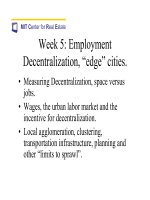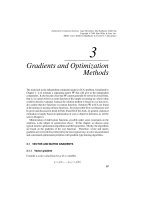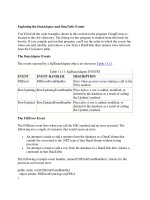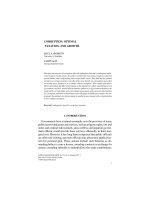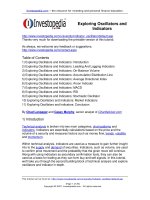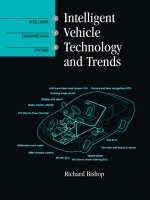Tài liệu Exploring blockchain technology and its
Bạn đang xem bản rút gọn của tài liệu. Xem và tải ngay bản đầy đủ của tài liệu tại đây (334.05 KB, 10 trang )
Chen et al. Smart Learning Environments (2018) 5:1
DOI 10.1186/s40561-017-0050-x
Smart Learning Environments
RESEARCH
Open Access
Exploring blockchain technology and its
potential applications for education
Guang Chen1,2, Bing Xu1, Manli Lu1 and Nian-Shing Chen3*
* Correspondence:
3
Department of Information
Management, National Sun Yat-sen
University, Kaohsiung, Taiwan
Full list of author information is
available at the end of the article
Abstract
Blockchain is the core technology used to create the cryptocurrencies, like
bitcoin. As part of the fourth industrial revolution since the invention of steam
engine, electricity, and information technology, blockchain technology has been
applied in many areas such as finance, judiciary, and commerce. The current
paper focused on its potential educational applications and explored how blockchain
technology can be used to solve some education problems. This article first introduced
the features and advantages of blockchain technology following by exploring some of
the current blockchain applications for education. Some innovative applications of
using blockchain technology were proposed, and the benefits and challenges of using
blockchain technology for education were also discussed.
Keywords: Blockchain, Educational evaluation, Instructional design, Learning is earning
Background
Blockchain is the core technology used to create the cryptocurrency, Bitcoin, through
the maintenance of immutable distributed ledgers in thousands of nodes proposed by
Satoshi Nakamoto in 2008 (Nakamoto 2008). It has been considered as part of the
fourth industrial revolution since the invention of steam engine, electricity, and information technology (Chung and Kim 2016; Schwab 2017). This disruptive technology
will have a significant impact on national governance, institutional functions, business
operations, education, and our daily lives in the 21st century. It has the potential to
transform the current Internet from “The Internet of Information Sharing” to “The
Internet of Value Exchange.” Blockchain technology is expected to revolutionize the
operating modes of commerce, industry, and education, as well as to promote the rapid development of knowledge-based economy on a global scale. Due to its immutability, transparency, and trustworthiness for all transactions executed in a blockchain network, this
innovative technology has many potential applications (Underwood 2016). During the initial stages of its appearance, blockchain technology was not able to draw a lot of attention.
However, as Bitcoin continues to run safely and steadily over the years, the society
has since become aware of the enormous potential of the underlying technology of
this invention in its application to not only cryptocurrency but also in many other
areas (Collins 2016). Blockchain technology has become a hot topic for more and
more countries, institutions, enterprises, and researchers.
© The Author(s). 2018 Open Access This article is distributed under the terms of the Creative Commons Attribution 4.0 International
License ( which permits unrestricted use, distribution, and reproduction in any medium,
provided you give appropriate credit to the original author(s) and the source, provide a link to the Creative Commons license, and
indicate if changes were made.
Chen et al. Smart Learning Environments (2018) 5:1
Presently, blockchain technology has been applied in various fields such as cryptocurrencies in the financial area, which includes Bitcoin, Ethereum, and Zcash (Zerocash),
etc. Bitcoin is the first peer-to-peer payment network of electronic cash based on the
blockchain technology. One of the crucial features of blockchain technology is how
many nodes in a distributed blockchain network maintain consensus and the Bitcoin
blockchain network adopts a hash-based Proof-of-Work (PoW) distributed consensus
algorithm (Nakamoto 2008). Ethereum is an open-source, public, blockchain-based distributed computing platform featuring smart contract functionality using proof-of-stake
consensus algorithm (Beck et al. 2016). Zcash is a decentralized and open-source cryptocurrency like Bitcoin. However, it offers a better privacy and selective transparency of
transactions by using proof-of-zero-knowledge consensus algorithm. Zcash payments
are published on a public blockchain, but the sender, recipient, and amount of a transaction remain private (Peck 2016). Besides, some organizations and enterprises are also
trying to develop decentralized platforms based on blockchain technology. For example
Arcade City, so-called “Uber Killer,” is a ride-sharing company that has integrated its
model in Ethereum, including identity and reputation systems (Zheng et al. 2017).
Ubitquity is a digital property management company that offers secure recording and
tracking records built on a blockchain platform.
Swan (2015) indicated that the development of blockchain applications could be divided into three stages; Blockchain 1.0, 2.0, and 3.0. Blockchain 1.0 is the deployment
of cryptocurrencies as a peer-to-peer cash payment system. Blockchain 2.0 is the extensive blockchain applications than simple cash transactions, including stocks, bonds,
loans, smart property, and smart contacts. Blockchain 3.0 is developing blockchain applications beyond currency, finance, and markets, such as in the areas of government,
health, science, literacy, culture, and art.
According to the previously mentioned principle, the current applications of
blockchain is still in the 1.0 and 2.0 stages. Most people do not know about the
term “blockchain,” not to mention the potential applications of using blockchain
technology. Although researchers discussed the usage of blockchain in the commercial area (Swan 2015), several studies focused on how blockchain technology
can be applied in education (Devine 2015; Sharples and Domingue 2016).
The remainder of this article will discuss the critical terminologies of blockchain
technology such as “distributed ledger,” “block and chain,” and “the verification mechanism.” In section 3, the current applications of blockchain technology in education is
reviewed. Following on to the four innovative applications of using blockchain
technology in education and the advantages are presented.
Literature review
What is blockchain?
Blockchain technology is also known as distributed ledger technology. It allows participants to secure the settlement of transactions, achieve the transaction, and transfer of
assets at a low-cost (Tschorsch and Scheuermann 2016). A sample flow of cryptocurrency blockchain transaction can be seen as follows. User A initiates a transaction to
User B via a peer-to-peer blockchain network. A cryptographic proof of identity (a pair
of public key and private) is used to the network to identify user A and user B uniquely.
Page 2 of 10
Chen et al. Smart Learning Environments (2018) 5:1
The transaction will then be broadcasted to the memory pool of the blockchain network waiting for transaction verification & validation. The new block is generated by
obtaining a certain number of approved nodes; this is called reaching consensus. After
reaching consensus, new “block” on the entire blockchain network is formed, and each
node updates its respective copy of the blockchain ledger. This block contains all the
transactions that occurred during this time. It is “linked” to the original block in the
network through the digital signature (Yli-Huumo et al. 2016). The consensus stage is
achieved through the use of a consensus algorithm. This process is called mining.
Namely, Peer-to-Peer network reaches consensus on the current state of the distributed ledger (Kraft 2016). Each node can vote through its CPU power to accept
valid blocks by taking extensions or reject invalid blocks by denying expansions.
Any required rules and incentives can be implemented through this consensus
mechanism (Nakamoto 2008). Each transaction in a block is tagged by a specific
timestamp. The two blocks are also linked by a timestamp. Therefore, the data on
the blockchain has a property of time, and the length of the chain is continuously
growing. It means that blockchain is a distributed variant that implements the
timestamp service (Haber and Stornetta 1991). Blockchain uses specialized hardware to construct sizeable cryptographic data chain, and SHA-256 hash function is used
to prevent the tampering of data of third-party users (Tschorsch and Scheuermann 2016).
Any attempt to change even just a bit of information will break the existing chains. In
short, blockchain is a decentralized and trustworthy digital public ledger. It uses distributed techniques and consensus algorithms that were maintained by all participants.
Blockchain is not only a new type of internet infrastructure based on distributed applications but also a new type of supply chain network. Essentially, blockchain is a distributed network of computers (nodes) used to maintain the source of information
sharing. Each node maintains the security and accuracy of the information by keeping a
complete set of ledgers of past transactions. When a new block is being created by a
miner, who is the first one to validate all the transactions in the block and solve the
mathematical problem by generating a digital signature for the block which meets a
pre-defined rule using the hash function. The newly created block will be broadcasting
to the whole blockchain network, allowing all nodes to maintain the same complete
ledger (Tschorsch and Scheuermann 2016).
Consensus mechanism is achieved through three major verification mechanisms.
Bitcoin uses a verification mechanism called Proof of Work (Nakamoto 2008). The
miners are nodes working in a blockchain peer-to-peer network. Their task is to
validate all transactions included in one block and solve the mathematical problem of
the digital signature using a hash function. The miners compete with each other, and
once someone solves the problem, the solution will be shared with other mining nodes.
The winning miner receives additional bitcoins as rewards. Other miners accept
the Proof of Work, and the new block will be added to the blockchain network
(Fanning and Centers 2016). Ethereum has four development stages, including
Frontier, Homestead, Metropolis, and Serenity. The first three stages use the verification mechanism of Proof of Work, and the fourth stage uses Proof of Stake. The
Proof of Stake requires the certifier to show the ownership of a certain amount of
cryptocurrency (Sharples and Domingue 2016). “Proof of Zero Knowledge” is the
consensus mechanism used in Zcash which can provide better privacy to its users.
Page 3 of 10
Chen et al. Smart Learning Environments (2018) 5:1
Compared with other verification mechanisms, Proof of Zero Knowledge has improved
both regarding functionality and efficiency (Tschorsch and Scheuermann 2016).
Features of blockchain technology
From the technical point of view, blockchain technology has four features:
decentralization, traceability, immutability, and currency properties.
Decentralization refers to the processes of data verification, storage, maintenance,
and transmission on blockchain which are based on a distributed system structure. In
this structure, the trust between distributed nodes is built through mathematical
methods rather than the centralized organizations.
Traceability means that all transactions on blockchain are arranged in chronological
order, and a block is connected with two adjacent blocks by the cryptographic hash
function. Therefore, every transaction is trackable by examining the block information
linked by hash keys.
There are two reasons that blockchain technology is immutable. On the one hand, all
transactions are stored in blocks with one hash key linking from the previous block
and one hash key pointing to the next block. Tampering with any transaction would result in different hash values and would thus be detected by all the other nodes running
precisely the same validation algorithm. On the other hand, blockchain is a shareable
public ledger stored on thousands of node, and all ledgers continue to sync in real time.
Successful tampering would need to change over 51% of the ledgers stored in the network (Tschorsch and Scheuermann 2016).
Blockchain technology and cryptocurrency are inseparable, that is to say, any
blockchain network has a form cryptocurrency property. The essence of blockchain
technology is point-to-point transactions, no third party is involved, which means
that all transactions do not require the participation of third parties. Circulation of
digital currency based on blockchain technology is fixed. Specifically, in Bitcoin,
the currency base is set at 21 million caps, so the generation of digital currency is
created by using a specific mining algorithm and is bounded by a pre-defined formula. Thus there won’t be the problem of inflation, collapse and so on. In Blockchain 2.0
and 3.0 applications, the combination of other activities such as government activities,
educational activities, and financial activities can make these non-financial activities have
the property of currency.
Advantages of blockchain technology
Derived from the above mentioned four technical features, some advantages of their
application using blockchain technology are described as follows.
Reliability: the decentralized nature of a blockchain network changes the databases of
the entire transaction records from closed and centralized ledgers maintained by only a
few accredited institutions to open distributed ledgers maintained by tens of thousands
of nodes. The failure of a single node does not affect the operation of the whole network. This avoids the single point of failure and ensures the high reliability of the
applications which built on the blockchain technology.
Trust: blockchain network makes the trust decentralized too. Unlike the centralized
trust we take for granted, such as central governments issuing currencies and
Page 4 of 10
Chen et al. Smart Learning Environments (2018) 5:1
commercial banks, blockchain network acts as new trust bearers with decentralized
ledgers. These ledgers are shared among a network of tamper-proofed nodes
(Underwood 2016).
Security: blockchain network uses the one-way hash function which is a mathematical
function that takes a variable-length input string and converts it into a fixed-length binary sequence. The output bears no apparent relationship to the input. The process is
hard to reverse because, given just the output, the input is impossible to determine
(Yli-Huumo et al. 2016). Furthermore, the newly generated block is strictly following
the linear sequence of time.
Efficiency: all data are automatically run through pre-set procedures. Therefore,
blockchain technology can not only significantly reduce the cost of labor but also
improve efficiency. For the digital currency of Blockchain 1.0, the automation of distributed ledger is mainly the automation of settlement. Blockchain technology could
speed the clearing and settlement of certain financial transactions by reducing the
number of intermediaries involved, and by making the reconciliation process faster and
more efficient (Wang et al. 2016).
Educational applications using blockchain technology
Present blockchain applications in education
Nowadays, some universities and institutes have applied blockchain technology into
education, and most of them use it to support academic degree management and summative evaluation for learning outcomes (Sharples and Domingue 2016; Skiba 2017).
Blockchain technology can formulate the whole transcript. In the formal learning
context, this includes learning contents and outcomes as well as students’ achievements
and academic certificates. Subsequently, in the informal learning context, information
about research experience, skills, online learning experience as well as individual
interests are included. These data can be safely stored and accessed on a blockchain
network in appropriate ways. The University of Nicosia is the first school which uses
blockchain technology to manage students’ certificates received from MOOC platforms
(Sharples and Domingue 2016). Sony Global Education also used the blockchain
technology to create a global assessment platform to provide services for storing and
managing degree information (Hoy 2017). Additionally, Massachusetts Institute of
Technology (MIT) and the Learning Machine company cooperated to design a digital
badge for online learning based on blockchain technology. Students who have attended
the projects of MIT Media Lab and passed the assessment will receive a certification
which will be stored on a blockchain network (Skiba 2017). What’s more, Holberton
School is the first institute applying blockchain technology to store degrees and has
claimed that they would share this information from 2017. The blockchain ledger can
match all kinds of educational information with the user’s unique ID. It includes
learning behavior in class, micro academic project experience, and macro educational background, etc.
Moreover, blockchain technology contributes to reducing degree fraud. In the past,
there were numerous cases of degree fraud. However, it can be avoided by employing
blockchain in granting and managing student’s degree now. The data matched with
users’ ID and stored in blockchain are checked, validated, and maintained by the
Page 5 of 10
Chen et al. Smart Learning Environments (2018) 5:1
miners from all over the world. Blockchain distributed ledger is immutable and trustworthy. Thus, the reliability and authority are both ensured, which will significantly reduce degree fraud.
Also, blockchain can be used as a “capacity-currency transformation bank.” Specifically, blockchain learning ledger records detailed information about the users’ learning
experience and follows the development of their knowledge and skills. All of them can
be transformed into a sort of digital currency and stored on a blockchain network according to a series of comprehensive standards. Students will gain rewards through their efforts on studies, which is called “learning is earning” (Sharples and Domingue 2016).
Some schools have also started the application with this concept, for example,
Sharples and Domingue (2016) claimed a kind of Education Reputation Currency
named Kudos. It can be used to measure learning outcomes and stored in a
virtual wallet.
Future innovative educational applications using blockchain technology
Blockchain technology can be applied to education in many innovative ways beyond
just diploma management and achievements assessment. For both learners and
teachers, blockchain technology has a great potential for broader application prospects
on formative evaluation, learning activities design and implementation, and keep
tracking the whole learning processes. Some innovative applications of using blockchain technology in the field of education are proposed as follows.
A Smart Contract running on the Ethernum blockchain network is essentially a
computer protocol that simulates a real contract (such as economic transactions,
employment, etc.) (Kosba et al. 2016). It can facilitate contract negotiation, simplify
contract terms, implement contract execution, and verify contract fulfillment state.
It marks the unique and precise identity of parties in a transaction (contract subjects) through a digital way and stipulates the rights and obligations of both sides
(contract terms) by code. The smart contract not only reduces “third party costs”
in traditional transactions but also dramatically guarantees the transaction security
and reliability. For example, in the context of car-installment, the buyer negotiates
with the seller directly rather than loans from the bank, saving any additional processing fees. If buyer breaks the rules, the code will be executed, and the smart
contract will be terminated. The smart contract greatly improves executive power
and fairness than the traditional one. Therefore, if teachers and students carry out
instructing and learning activities based on a smart contract, some of the educational issues would be solved.
From the perspective of students, there are still some negative subjective or objective
factors causing poor learning outcomes, such as the lack of motivation and financial
pressure. Due to the trait of currency property, blockchain can be used to motivate students by implementing “learning is earning” (Sharples and Domingue 2016). The smart
contract between teachers and students can be applied to the educational scenario.
Real-time awards can be given to students through some simple clicks by the instructors. Students will get a certain number of digital currency according to smart contract
as rewards. This kind of money can be stored in the education wallet, used as tuition,
even exchanged with real currencies.
Page 6 of 10
Chen et al. Smart Learning Environments (2018) 5:1
Evaluation is also a problematic issue in the education system. Formative assessment
has been advocated for a long time, and yet it is still not ripe because it is not easy to
track every detail of teaching and learning. Applying blockchain and smart contract can
cope up with this challenge. Notably, the immutability, traceability, and reliability of
blockchain mean that the data recorded on blockchain are more specific, authentic,
and anti-theft. Take the “collaborative learning” for instance, which is regarded as an
excellent way to carry out constructivism instruction and cultivate students’ ability to
work with others. However, it is often accompanied by the problem of free-riding
hindering fair evaluation. Blockchain technology can mitigate this phenomenon. Each
student submits his/her work to the learning platform through his/her unique account,
the smart contract running on it will review student’s performance, and the results will
be recorded into blocks. All behaviors during collaboration will be saved into blocks as
evidence for evaluation as well. Moreover, public blockchain has the trait of
decentralization. It means that the distributed ledger ensures the consistency of most
nodes. Thus, as nodes in blockchain network, students’ opinions would be taken into
consideration when assessing them. In this context, blockchain ensures the fairness of
the evaluation.
From the perspective of teachers, the instruction is sophisticated and artistic so that
it is difficult to evaluate. The traditional method based on students’ feedback tends to
be one-sidedness, lacking subjectivity and is hardly helpful for teachers’ improvement.
A new assessment system can be constructed based on blockchain network and smart
contract. First, teachers need to submit preplanned instructional activities as a smart
contract to the schools. During the teaching process, all teaching activities will be recorded in the blockchain network. The smart contract will verify the consistency of the
teaching design and practice, which is going to be an important instruction evaluation
indicator. What’s more, a smart contract between teachers and schools, as well as the
one between teachers and students can be verified and supplemented with each other.
Teachers who meet the standards will get digital currency as a reward. It serves as both
an appreciation and encouragement for teachers’ teaching skills.
From the perspective of student development, supervisor or academic advisor is
directly responsible for the supervision of the student’s program. They have the responsibilities of assisting the student in planning study programs and staying informed of
student’s research activities and progress. However, in practice, these issues are not
checked and supervised, so it will be controversial to distinguish the responsibilities if
something negative happens in the future. This situation will be changed if smart contract and blockchain technology is used in this area. All details should be monitored by
smart contract platform and recorded into blockchain ledger. Such as how many times
has the supervisor discussed with students in the past semester? How many times has
the supervisor reviewed the thesis both in draft and final form? Whether they provide
appropriate guidance to the students in course selection and research design? Thanks
to the traceability and immutability of blockchain technology, both students and supervisors’ behaviors will be recorded in the blockchain ledger. This innovative application
can protect the interests of both parties.
Overall, blockchain can be used to construct a balance to measure learning process
and outcomes. It is a reliable and an equal proof of value for everyone. Theoretically,
blockchain can solve the problems of information asymmetry and trust among
Page 7 of 10
Chen et al. Smart Learning Environments (2018) 5:1
strangers because of its decentralization and immutability. It ensures the authenticity
because the information and value are published and maintained collectively. It provides a trustworthy way for talent investment. The user with more education on digital
currencies has much chance to win the appreciation and investment. Blockchain ledger
tracks everything you’ve ever learned. Employers can use this information to offer
you a job that matches your skills. On the other hand, the user who wants an
excellent employee can also resort to the blockchain ledger. It will greatly decrease
the risk of investment bias and failure. In a word, blockchain maximizes the
interests of both parties.
Potential issues of applying blockchain technology in education
It is undeniable that there are potential drawbacks of applying blockchain technology
in education.
As a complex system, some learning behaviors and learning outcomes need to be
reviewed by the instructors subjectively such as essays and classroom presentations. It
is quite hard to evaluate this kind of learning activities by the pre-programmed smart
contract without human intervention.
If an educational blockchain system were put into use in schools, all students’ educational data would be integrated into blockchain ledgers. The immutability feature of
blockchain technology would act as a double-edged sword. It removes the possibility of
modifying educational record for legitimate reasons for some students.
Furthermore, many technical issues or barriers are not addressed for the blockchain to be used in education. For example, the classic Proof of Work consensus
mechanism wastes energy and has a poor performance in terms of number of
transactions per second (Vukolić 2015), which would cost an extra expense, and
hinder its application in schools.
Conclusion
Blockchain is essentially a distributed ledger technology, which uses the cryptograph techniques and distributed consensus algorithms to create the features of
decentralization, traceability, immutability, and currency properties. It’s currency
properties has the potential to trigger many innovative applications for education.
For example, by realizing “learning is earning,” blockchain technology can foster
students’ learning motivation. It can store a complete, trustworthy set of record of
educational activities including the processes and results in formal as well as informal learning environments. It can also record teachers’ teaching behaviors and performance thus providing a reference for teaching evaluation. In a word, for both
learners and teachers, blockchain has great potential applications in instructional design,
behaviors recording, and analysis as well as formative evaluation. At the same time, it
brings challenges and opportunities to researchers, developers, and educators.
For researchers, blockchain has excellent potential to be broadly applied in education.
However, very few researches have been conducted. It would be challenging to study
more closely on topics like, what opportunities can it offer for education revolution?
How to better utilizing the digital currency property to enhance learning motivations
and achievements?
Page 8 of 10
Chen et al. Smart Learning Environments (2018) 5:1
For developers, these creative ideas are just the first steps of applying blockchain into
education. It is also an important part to develop educational platforms and software,
which brings challenges for developers. How to build a blockchain platform that meets
users’ personalized needs? How to combine hardware with blockchain to create an environment for data acquisition and recording? How to maintain a massive volume of
educational transaction data and integrate blockchain technology into the existing educational tools and systems?
For educators, some of the benefits of adopting blockchain technology to design smart
contact-based learning activities are smart contract-based learning activities can be verifiable, robust, and traceable. This transparency feature is a strong protection for teachers
who have done a good job. Furthermore, the school management regarding the evaluation
of teaching performance should also be changed to embrace this new technology.
The realization of 21st century’s security, privacy, trust, and equality can be implemented
by blockchain technology. Security refers to the protection of valuable properties and information. Nowadays some people have property but cannot prove ownership, such as intellectual property disputes. It may lead to conflict with others. Blockchain technology can be
used by checking the records in the database to prove the properties. Some business information, such as design drawings, corporate planning, may be stolen by industrial spies.
Blockchain technology can be used to protect these valuables business by recording data in
a blockchain network. Blockchain technology protects teachers’ instructional design from
usurpation, thus improving the security of protecting intellectual properties.
Privacy means each node save the complete ledger, including all the information except for the real identity. For the sake of privacy, users’ identifications are all presented
by ID numbers. It means that blockchain technology protects the privacy of the trader,
as no one else would have the private key. In the education scenario, all the information about learning experience recorded on blockchain can only be gained by its unique
user’s private key. Others are not accessible, which means blockchain users’ privacy can
be well guaranteed.
As for trust, blockchain technology can transform people’s ways of constructing trust from
building it by the third-party institution to building it by technology. Teachers’ and students’
behaviors are both recorded and monitored when smart contract and blockchain are applied. The trust between the subjects is based on the technology itself, not the third-party.
Equality refers to the equal rights and opportunities that everyone has on a blockchain network. The openness, borderless and permissionless natures of blockchain
technology can provide everyone equal access to the technology and the network built
with it. Anyone can apply for an electronic wallet on blockchain network. Blockchain
technology does not set any limits for the users. All schools, teachers, and students can
apply it to daily, thus avoiding authority-bias.
Acknowledgements
Not applicable
Funding
Not applicable
Availability of data and materials
Not applicable
Authors’ contributions
My co-authors have all contributed to this manuscript and approve of this submission.
Page 9 of 10
Chen et al. Smart Learning Environments (2018) 5:1
Authors’ information
Dr. Guang Chen is Assistant Professor in the School of Educational Technology, Faculty of Education, Beijing Normal
University. His current research interest is cognitive development in information age and smart learning environments.
Bing Xu is a Master in the School of Educational Technology, Faculty of Education, Beijing Normal University. Her current
research interest is smart learning environments and digital reading.
Manli Lu is a Master in the School of Educational Technology, Faculty of Education, Beijing Normal University. Her current
research interest is online synchronous learning and smart learning environments.
Dr. Nian-Shing Chen is Chair Professor in the Department of Information Management at the National Sun Yat-sen
University, Taiwan. His current research interests include assessing e-Learning course performance; online synchronous
teaching & learning; mobile & ubiquitous learning; Natural user interface & Game-based learning.
Consent for publication
Neither this manuscript nor any significant part of it is under consideration for publication elsewhere or published or
available elsewhere in a manner that could be construed as a prior or duplicate publication of the same or substantially
overlapping content.
Competing interests
The authors declare that they have no competing interests.
Publisher’s Note
Springer Nature remains neutral with regard to jurisdictional claims in published maps and institutional affiliations.
Author details
1
School of Educational Technology, Faculty of Education, Beijing Normal University, Beijing, China. 2Beijing Key
Laboratory of Education Technology, Beijing Normal University, Beijing, China. 3Department of Information
Management, National Sun Yat-sen University, Kaohsiung, Taiwan.
Received: 5 September 2017 Accepted: 21 December 2017
References
R Beck, JS Czepluch, N Lollike, S Malone, Blockchain – The Gateway to Trust-Free Cryptographic Transactions. In
Research Papers from ECIS2016, (Istanbul, 2016)
M Chung, J Kim, The internet information and technology research directions based on the fourth industrial revolution.
KSII Trans. Internet Inf. Syst. 10(3), 1311–1320 (2016)
R Collins, Blockchain: A new architecture for digital content. EContent 39(8), 22–23 (2016)
P Devine, Blockchain learning: can crypto-currency methods be appropriated to enhance online learning? Presented at
the ALT Online Winter Conference 2015, Online, (United Kingdom, 2015)
K Fanning, DP Centers, Blockchain and its coming impact on financial services. J. Corp. Account. Finance 27(5), 53–57
(2016) />S Haber, WS Stornetta, How to time-stamp a digital document. J. Cryptol. 3(2), 99–111 (1991) />1007/BF00196791
MB Hoy, An introduction to the Blockchain and its implications for libraries and medicine. Med. Ref. Serv. Q. 36(3), 273–279
(2017) />A Kosba, A Miller, E Shi, Z Wen, C Papamanthou, in 2016 IEEE Symposium on Security and Privacy (SP). Hawk: The Blockchain
Model of Cryptography and Privacy-Preserving Smart Contracts (2016), pp. 839–858 />D Kraft, Difficulty control for blockchain-based consensus systems. Peer Peer Netw. Appl. 9(2), 397–413 (2016)
/>S Nakamoto, Bitcoin: A peer-to-peer electronic cash system. (2008) Retrieved from />M Peck, A blockchain currency that beat s bitcoin on privacy. IEEE Spectr. 53(12), 11–13 (2016)
/>K Schwab, The Fourth Industrial Revolution (The Crown Publishing Group, New York City, NY, 2017)
M Sharples, J Domingue, in The Blockchain and Kudos: A Distributed System for Educational Record, Reputation and Reward.
Adaptive and adaptable learning (Springer, Cham, 2016), pp. 490–496 />DJ Skiba, The potential of Blockchain in education and health care. Nurs. Educ. Perspect. 38(4), 220–221 (2017)
/>M Swan, Blockchain: Blueprint for a New Economy, 1st edn. (O’Reilly Media, Sebastopol, CA, 2015)
F Tschorsch, B Scheuermann, Bitcoin and beyond: A technical survey on decentralized digital currencies. IEEE Commun.
Surv. Tutorials 18(3), 2084–2123 (2016) />S Underwood, Blockchain beyond Bitcoin. Commun. ACM 59(11), 15–17 (2016) />M Vukolić, in The Quest for Scalable Blockchain Fabric: Proof-of-Work vs. BFT Replication. Open problems in network
security (Springer, Cham, 2015), pp. 112–125 />H Wang, K Chen, D Xu, A maturity model for blockchain adoption. Financ. Innov. 2(1), 12 (2016)
/>J Yli-Huumo, D Ko, S Choi, S Park, K Smolander, Where is current research on Blockchain technology?—A systematic
review. PLoS One 11(10), e0163477 (2016) />Z Zheng, S Xie, H Dai, X Chen, H Wang, in 2017 IEEE International Congress on Big Data (BigData Congress). An Overview
of Blockchain Technology: Architecture, Consensus, and Future Trends (2017), pp. 557–564 />BigDataCongress.2017.85
Page 10 of 10
